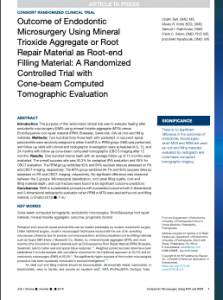Outcome of Endodontic Microsurgery Using Mineral Trioxide Aggregate or Root Repair Material as Root-end Filling Material: A Randomized Controlled Trial with Cone-beam Computed Tomographic Evaluation
Authors
- Chafic Safi, DMD, MS,
- Meetu R. Kohli, BDS, DMD
- Samuel I. Kratchman, DMD
- Frank C. Setzer, DMD, PhD, MS
- Bekir Karabucak, DMD, MS
Abstract
Introduction: The purpose of this randomized clinical trial was to evaluate healing after endodontic microsurgery (EMS) using mineral trioxide aggregate (MTA) versus EndoSequence root repair material (RRM; Brasseler, Savannah, GA) as root-end filling materials.
Methods: Two hundred forty-three teeth with persistent or recurrent apical periodontitis were randomly assigned to either the MTA or RRM group. EMS was performed, and follow-up visits with clinical and radiographic investigation were scheduled at 6, 12, and 24 months with follow-up cone-beam computed tomographic (CBCT) imaging after 12 months.
Results: One hundred twenty teeth with an average follow-up of 15 months were evaluated. The overall success rate was 93.3% for periapical (PA) evaluation and 85% for CBCT evaluation. The RRM group exhibited 92% and 84% success rates as assessed on PA and CBCT imaging, respectively. The MTA group exhibited 94.7% and 86% success rates as assessed on PA and CBCT imaging, respectively. No significant difference was observed between the 2 groups. Microsurgical classification, root canal filling quality, root-end filling material depth, and root fracture were found to be significant outcome predictors.
Conclusions: EMS is a predictable procedure with successful outcome both 2-dimensional and 3-dimensional radiographic evaluation when RRM or MTA was used as the root-end filling material. (J Endod 2019;-:1–9.)
Read full article here !
